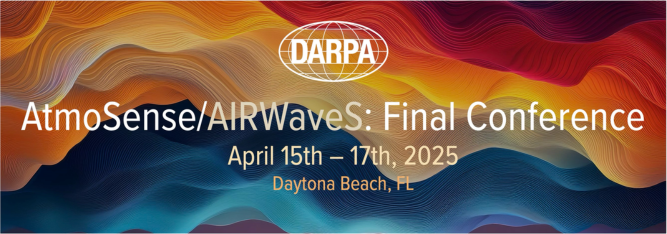
AtmoSense/AIRWaveS
DARPA is hosting this AtmoSense workshop to promote engagement within the science and technology community, build on the program's successes, and catalyze further research and development for national security. This event is closed to the general public and media. Media inquiries should be directed to outreach@darpa.mil. Registrations not indicating a connection to these communities or project partners may not receive a response.
Conference Quicklinks
Home | Registration | Agenda
🌍 Welcome to the AtmoSense/AIRWaveS Final Conference!
This conference provides an opportunity to share recent innovations in physics-based modeling, remote sensing, and experimental detection of atmospheric and ionospheric disturbances and foster interdisciplinary connections that can shape future research. We invite colleagues and new participants from the broader scientific community to join us in reporting and discussing strategies to continually advance the state of the art in modeling and simulation, experiment and observation.
The Defense Advanced Research Projects Agency (DARPA) Atmosphere as a Sensor Program (AtmoSense: https://www.darpa.mil/research/programs/atmosphere-as-a-sensor) is a fundamental science program to predict and understand the detectable manifestations of transient disturbances in the upper atmosphere and ionosphere. Because amplitudes of waves from these disturbances can become measurably large through the mesosphere and thermosphere, there is the possibility of detecting relatively small perturbations from remote sensing diagnostics — AtmoSense has sought to define minimum amplitudes of signals that can be measured at high altitudes.
AtmoSense’s Phase 1 engaged multiple teams of performers and focused on modeling and sensing various types of natural geophysical transient disturbances, e.g., from weather, seismic, and bolide sources. Under this program, the Embry-Riddle Aeronautical University (ERAU) team and academic and federal partners led the project AIRWaveS (Atmosphere-ionosphere Responses to Wave Signals). AIRwaveS’ Phase 2, now due for completion in May 2025, has focused on source-to-sensor model simulations and experimental field tests of explosive sources in May and October 2024.
The AtmoSense/AIRWaveS project spans ten organizations focused on advancing the modeling and remote sensing of ground-level impulsive disturbances. These disturbances, detected through ionospheric HF radio, GNSS TEC, and pressure sensor measurements pose challenges to current numerical models due to their extreme requirements in resolution and coupling across physics-based models. AIRWaveS has addressed these complexities by integrating adaptive mesh refinement, new multi-physics simulation coupling frameworks, and data synthesis capabilities to increase our understanding of atmosphere-ionosphere interactions and the observable signatures of transient events. Controlled experiments thus test the detectability of various sources and their signals to provide a reference basis for model validation.
Phase 2 of the AtmoSense program has successfully demonstrated the detectability of these signals across various radio diagnostics to provide new insights into how measurements of the ionosphere can improve source characterization—including insight into mechanical wave amplitude, timing, and geolocation—with a new basis for simulation using advanced computational modeling techniques. This highlights a new basis for simulations of effects from transient geophysical and manmade phenomena, from the atmosphere to the overlying ionosphere, and thus from source to sensor.
Phase 2 Research Partners include (in addition to ERAU) Boise State University, University of Bonn, Boston University, Duke University, U.S. Naval Research Laboratory (NRL), U.S. Air Force Research Laboratory (AFRL), Los Alamos National Laboratory (LANL), Sandia National Laboratories (SNL), Utah State University’s (USU) Space Dynamics Laboratory (SDL), and New Mexico Tech’s (NMT) Energetic Materials Research and Testing Center (EMRTC).
AtmoSense/AIRWaveS research at ERAU and its academic partners was supported under DARPA Cooperative Agreements HR00112120003 and HR00112320043 to Embry-Riddle Aeronautical University. This work is approved for public release; distribution is unlimited. The content of the information does not necessarily reflect the position or the policy of the Government, and no official endorsement should be inferred.
What to Expect at This Conference
Registration for the conference is free and will have both an in-person and online component. This conference serves as a platform to:
- Summarize key accomplishments from Phase 2, including new experimental field tests and applications of numerical simulations.
- Connect AtmoSense researchers with experts from related fields, such as Heliophysics, space weather, applied mathematics, computation, remote sensing, seismoacoustics and infrasound, to foster collaboration.
- Encourage cross-disciplinary innovation through presentations from AtmoSense researchers and talks from broader scientific communities.
- Identify and grow follow-on research pathways for the scientific community to build upon DARPA AtmoSense research.
We look forward to engaging in discussions, presentations, and new research connections to help us advance the study of atmospheric and ionospheric disturbances and processes, especially those occurring over small spatial and short time scales.
Explore the Conference Program & Register:
- Registration
- Social Events
- Discounted Attraction Tickets
- Venue & Travel Information
- Food & Local Offerings
- Contact
Please consider registering or contacting us with any inquiries. During registration, you will have the option to indicate your interest in presenting. We appreciate your interest and look forward to your contributions. Please contact us if you have any questions or need assistance with the registration process (Jaime Aguilar—j.aguilar@erau.edu).
Browse the contents of AtmoSense/AIRWaveS:
- AtmoSense/AIRWaveS: Final Conference
- April 15 - 17 @ The Shores Resort & Spa – Atlantic Room (rooftop)
- Hackathon
- Past Event: March 8 –10, 2025 @ Duva #1 (Henderson Welcome Center)
